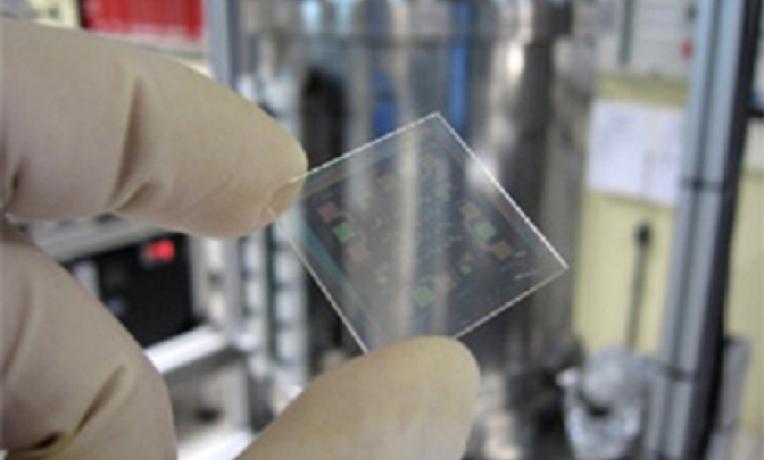See-through electronics
Forget USA, Japan; the field of transparent electronics has put Portugal well and truly on the map thanks to Professor Elvira Fortunato and one of the largest grants awarded to a Portuguese scientist. The European Research Council grant contributed to the installation of the recently opened NOVA Nano-Fabrication Laboratory, of which Prof Fortunato is the Director.

The world of electronics has become see-through! Imagine having a fully transparent flexible screen, an invisible security camera or even an intelligent window because of state-of-the-art transparent electronic circuits developed by Professor Fortunato and her team. These ideas might sound far-fetched and futuristic, but ‘impossible’ is not in Professor Fortunato’s dictionary. Having already researched the development of transparent thin film transistors using novel metal oxides that act as semiconductor materials, she is certain that this is the future for electronics.
In February 2011, Professor Fortunato became the Director of the new Nano-Fabrication Laboratory at the Centre of Materials’ Research, Lisbon New University (UNL). The laboratory was officially inaugurated in presence of the President of the Republic of Portugal, Anibal Cavaco Silva.
Professor Fortunato’s team have shown that metal oxides such as zinc oxide can be used in electronics as semiconductor transistors that could prove to be better than current semiconductor materials, such as silicon. Zinc oxide, a transparent ceramic, has been commonly used for centuries as an anticorrosion tool for coating pans. Nowadays, it is also used for coating jewellery accessories, in rubbers, e.g. in tyres, in concrete construction and cosmetics for instance in sunblock creams.
One of the major advantages of this novel use is that metal oxide semiconductor devices do not produce as much waste heat. They are also cheaper, faster and do not degrade. Unlike other research groups, Professor Fortunato’s team have processed metal oxides at room temperature, making it a cheaper and easier method of manufacture than using powerful ovens.
These electronic systems will not only be useful in leisure devices, but also in laboratory equipment for detecting proteins and genetic material. Working alongside Samsung, Elvira and her team are developing the first transparent television screen, and with Fiat, the first ‘windscreen of the future’, where drivers can have digital displays appear and disappear on their car windscreen. This fundamental research will lead to innovative developments in other multi-billion dollar industries involving electronics, such as ink-jet printing and medical diagnostics that the full extent of these applications is unfathomable.
Professor Elvira Fortunato is a pioneer in the field of transparent electronics, namely Thin Film Transistors (TFTs) and holds sixteen patents as author and co-author, one of which is with Samsung. She received an ERC Advanced Grant for her project INVISIBLE.
Glossary
- A semiconductor conducts electricity, but is neither a conductor like a metal, or an insulator. Semiconductors are important in the field of electronics. Silicon is an example of a semiconductor. A transistor is a semiconductor device used to make electronic signals ‘larger’ i.e. enabling the output power to be more than the input power. Transistors make up modern electronic devices, and as they are so small, allow electronic devices to be portable.
- A metal-oxide-semiconductor is a where an oxide layer of the main semiconductor material is added as an insulator. So for example, on a silicon semiconductor, the insulating layer is silicon dioxide.
- Thin film transistors (TFT) are when thin films of semiconductor material are laid on a surface, rather than the surface of the transistor itself being made of the semiconductor material. They are used in TV or laptop flat screens.
Links
- Professor Elvira Fortunato’s CV and publications
- New NOVA Nano-Fabrication Laboratory, housed within the Centre of Materials’ Research, Caparica Campus of the Faculty of Science and Technology of Lisbon New University (UNL)
- Video of the Inauguration Ceremony
Landmark publications
- Fortunato, E..; Barquinha, P. M. C; Pimentel, A.; Goncalves, A. M. F.; Marques, A. J. S.; Pereira, L. M. N.; Martins, R. F. P., Fully transparent ZnO thin-film transistor produced at room temperature. Advanced Materials 2005, 17, (5), 590.
- Fortunato E., Barquinha PMC, Pimentel A, Goncalves AMF, Marques AJS, Martins RFP, Pereira LMN (2004): Wide-bandgap high-mobility ZnO thin-film transistors produced at room temperature. Applied Physics Letters 85:2541-2543.
- Assuncao V, Fortunato E, Marques A, Aguas H, Ferreira I, Costa MEV, Martins R (2003): Influence of the deposition pressure on the properties of transparent and conductive ZnO:Ga thin-film produced by r.f. sputtering at room temperature. Thin Solid Films 427:401-405.
- Fortunato E, Ginley D, Hosono H, Paine DC (2007): Transparent conducting oxides for photovoltaics. Mrs Bulletin 32:242-247.
- Fortunato, E.; Barros, R.; Barquinha, P.; Figueiredo, V.; Park, S. H. K.; Hwang, C. S.; Martins, R., Transparent p-type SnOx thin film transistors produced by reactive rf magnetron sputtering followed by low temperature annealing. (2010) Applied Physics Letters, 97, (5).
More Striking Projects
Download the 2010 Striking Project brochure with more projects funded by the European Research Council since 2007.
Find all abstracts of ERC-funded projects on the CORDIS website, Select Theme: "FP7-IDEAS".


